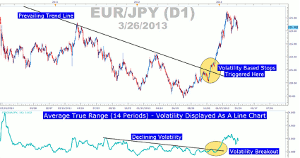Volatility extremes can help you spot great entries and assess your value at risk (VaR), writes Tyler Yell of DailyFX.com, so you can ensure that you’re not taking on too much risk for your trading system.
Volatility is at the heart of many trading systems because volatility helps you understand the potential risk your trade can be exposed to. Newer traders often use volatility or big moves as the bait to get into a trade that could make them rich, assuming the trade will go in a straight line (it usually won’t). However, experienced or systematic traders will use volatility to understand the risk they’re taking on a given trade when coupled with trade size.
Volatility Based Stops Have Been Used to Avoid Being Trapped in a Counter Move

(Created using FXCM’s Marketscope 2.0 charts)
Click
to Enlarge
If you’re familiar with standard deviation, then you already are more familiar with the value at risk concept than you realize. While the subject of value at risk is too vast to cover in this article alone, understanding standard deviation will help you understand volatility and the likelihood or probability of price traveling outside of historical volatility so that you can gauge strong entries with the trend and place stops with confidence when taking a trade. Two common methods to gauge present volatility are through average true range or John Bollinger’s Bollinger Bands, which uses standard deviation.
Standard Deviation Can Help You Grasp the Probability of Probable Price Action
The concept of trading with the trend and setting your stop exits based on out of range volatility moves can be visualized through a distribution curve. In short, the x-axis above shows you the likeliness of an event taking place with 70% of price action happening within 1 standard deviation whereas 95% percent of price action will take place within 2 standard deviations and 99% within 3 standard deviations. In short, if price goes outside of 3 standard deviations (visualized through the Bollinger Bands) with the trend staying intact, you can look to take a high probability entry off the rejection of that price swing and set your stop closely above your entry.
Bollinger Bands Help You Understand You Find Entry and Exit Points

(Created using FXCM’s Marketscope 2.0 charts)
Click
to Enlarge
The chart above shows you entering in the direction of the trend after a counter trend move may have exhausted and price continues with the trend. The value at risk concept with the chart above can be seen through the eyes of entering off of a statistically rare event against the trend. Therefore, you can enter with the trend with a high level of confidence because your exit can be set above your entry, which was based off a statistically rare event and reduces the likeliness of getting stopped out.
NEXT PAGE: Keep Position Size Under Control
|pagebreak|How Does VaR vary from Average True Range (ATR)?
As the name implies, ATR looks at the mean/average of volatility, which is helpful but can be limited because price can snap outside of average price on a news shock. However, ATR is still valuable and can be a simple approach to setting stops but is not useful for entries because it is non-directional. Stops based on ATR are usually based on multiples of ATR (ex. 3 * ATR) so you’re not taken out by the noise of normal moves.
How Has the VaR Concept Helped Traders?
Thinking and trading in terms of probabilities is one of the major forces behind allowing a trader to work a trading system to get the most out of your edge against the market. Regardless of your stop or entry confidence, we recommend that you risk no more than 5% of your equity. Taking a sample $10,000 account, you’re now looking at reducing the probability of losing more than 5% or $500 of your account.
Naturally, you want that potential to be as limited as possible, which is the purpose of the article. In order to keep that potential limited, you’ll still need to focus on position size to manage risk and be aware of how news events have affected the currencies historically.
When Has VaR Failed Traders?
When volatility snaps outside its historical average, that small percentage loss is hit and can result in a large loss. This happened across the board in wake of the 2008 credit crisis. Entire financial institutions used VaR to get the most out of their trading desks but they were leveraged up to 40x their book value (way above our 5x recommendation) and when volatility snapped outside their historical limits, it brought major institutions down.
A Simplified Approach for Your Trading
In the end, this new science of risk management concept is meant to help you confidently understand how much capital (i.e. value) is at risk at any one time based on historical volatility. The problem with the past is that it’s the past and tail risk events (from a standard deviation point of view) lie in wait. However, you can use the VaR concept to limit the amount you could lose in a really bad week, month, or year by using this concept.
Closing Thoughts
Trading with the trend will always be paramount regardless of the latest and greatest tool or concept in the market. Whether you define risk with the average true range, average true range multiples, or Bollinger Band rejections on the chart, you must keep your trade size in control so you have the capital to take the next trade in the direction of the trend.
By Tyler Yell, Trading Instructor, DailyFX.com





















